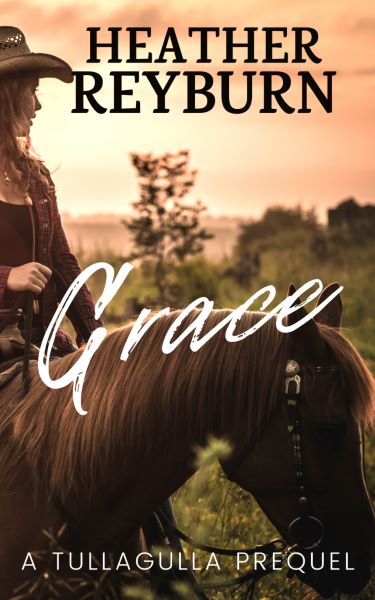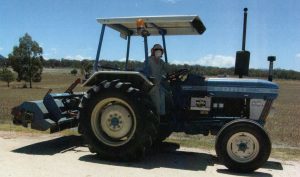
Join my mailing list to read for free!
100% privacy guaranteed.

100% privacy guaranteed.
On every farm, machinery is necessary for so many reasons. However, as more of an animal oriented person, to me, machinery has always been a challenge—and a mystery.
During my life on the land, I became adept at driving any vehicle, large or small, maintaining equipment and generally grasping enough basics required to run a successful property. In all the years of vehicles and equipment, the two standouts that provided both character and loving memories were my little Ford tractor and the Isuzu truck that we used to transport competition horses around the country.

The tractor was easy to drive, easy to attach and detach accessories from and—mostly–very reliable. Used for many jobs, the most common purposes were to rake hay and mow pasture. I had a Behrend mulching mower that attached to the back of the tractor— a noisy but incredible invention, allowing me to regularly slash paddocks for weed control and to spread the native grass seeds. This encouraged the hardy, nutritious feed for sheep and stabilised the ground. However, the mower blades were sharp and efficient, and as we chuffed around the paddocks, it not only chomped up the clumps of horse manure and tidied up the grasses, but also rapidly destroyed anything that blew into its path, including my well-worn and much loved Akubra hat, caught by an unexpected gust of wind.
The truck was a much loved 1980 Isuzu with a permanently fixed horse crate on the back. My daughters and I travelled many kilometres with up to five horses on board, attending shows, Pony Club and all manner of horse competitions. The engine took a while to warm up, and during the essential warm up routine, the glow plugs had to be lit for a full minute before attempting to pull the start button. Then, once it burst into life, the exhaust blew clouds of grey smoke for a couple of minutes. This meant that the horses (and people) needed to stand back until the old girl was warm and happy to move, then we loaded up and travelled without attracting attention. On one occasion, we had parked well away from others at a two day competition. We camped in the back of it and, on the final day of competition, I started her up in preparation for the homeward journey. The smoke billowed and we had a frantic visitor come running down the hill, thinking we were on fire. Sadly, we knew the truck would need an engine rebuild before too long, however we ploughed on with the help of our wonderful diesel mechanic for another two years after that.

On another occasion, we were driving home from the Goondiwindi Show, a distance that took a little over two hours. As we left the Showgrounds, the girls suggested we stop at the Omanama shop for an ice-cream. Lovely idea! As we drew near the turn off, I put my foot on the clutch and went to change down. To my horror, the clutch dropped straight to the floor without resistance. I had no clutch! Ice-creams forgotten, I informed the girls we wouldn’t be stopping until we got home—or at least close enough to be able to ride the horses the remainder of the journey if we had to stop. My memory dredged up a driving lesson given by an ex-boyfriend many years before—one who’s hobby was car rallying. He had taught me how to listen to my revs and change gears without using the clutch. At the time, I had no idea that this lesson was to become such a life saver thirty years later.
With about fifty kilometres of hills to negotiate in the middle of the flatter areas, the three of us sat in complete silence, listening attentively to the revs while I changed between third, fourth and fifth gears as we traversed the hills. We flew down as fast as the old girl would go in order to have enough oomph to get up the other side without needing second gear. Managing in this way, we made it back into Warwick with only three major turns to home. The first two were in third gear, necessitating a pathetic chug, chug away from the corner but the last was a sharp T-intersection which I knew I would not be able to negotiate in any gear above second. With no synchromesh in the two lowest gears, we slowed as much as possible, and with the help of my daughter sitting in the middle, we wrestled and graunched the gear stick until it dropped into second. We breathed a sigh of relief, puttered home, turned into our driveway and did a stalling stop! A journey never to be forgotten.
On another occasion, my sister from New Zealand was staying with us on holiday. After an early morning start in mid-winter, the girls headed off in the car, leaving my sister and I to follow in the truck with the horses and two dogs—who loved to come with us. I went through the usual starting procedure and backed the truck out of the shed. We loaded the horses, then hoisted the dogs into the cab. My sister climbed in and pushed the dogs into the middle seat (they much preferred to sit by the window). I hopped into the drivers seat and we set off. Half-way along the New England Highway, my sister shouted, her horrified voice several notches higher than usual. She could see the road passing underneath us and must have been concerned that the truck was falling apart. I reassured her that it was normal—just the lack of seals in some areas and the worn matting on the floor. I passed her the cushion I kept behind my back and she stuffed it against the door beneath her feet, blocking the vision—and the icy draught. Then we proceeded onwards for a successful weekend.
As the girls grew up and left home, our horse numbers reduced and we were able to return to using the horse-float—so the dear old truck was sold. We have no idea where she is now but hope her owner has as much fun in her as we did.
What a nice story and interesting life. How lucky you all are to have these wonderful stories to tell.